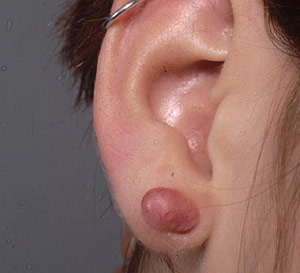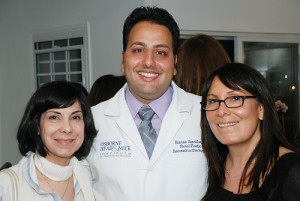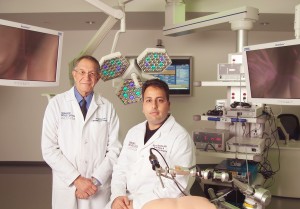- Keloids From Piercing - May 30, 2013
Question: I got my ear pierced, and now my ear has a swollen, itchy, and painful growth on it. My doctor said I have a keloid. What does this mean?

Discussion:
What is a keloid?
A keloid is a type of scar composed of a fibrous connective tissue called collagen. At the site of a healed injury, even an intentional injury like a piercing, these collagen fibers overproduce and the scar tissue forms, causing a red, swollen area near the injury. Keloids can be recognized by the toughness of the swollen skin, the irregular shape of the swollen area, and the pink or purple color that a keloid presents. The distinuguishing feature of the keloid scar versus other types is that it extends beyond the injury site itself into normal tissue. For example, a small piercing can result in a significantly keloid involving the entire earlobe.
What are the symptoms of a keloid?
Keloids are raised and look shiny and dome-shaped, ranging in color from brown to pink to red. Some keloids become quite large and unsightly. Along with the cosmetic deformity keloid scars tend to be pruritic, tender, or painful to the touch.
Where do keloids occur?
Keloid most common sites of occurrence include:
- chest
- back
- shoulders
- ears
Keloids may occur in an area of the body.
Who is susceptible to developing keloids?
Keloids are equally common in men and women. Risk factors for keloid formation include:
- darker skin types
- dertain races (Polynesian, Chinese, African American)
- age 10-30
Children and the elderly are less likely to develop these keloid scars but it is not clear if this is because keloid inducing procedures (i.e., piercings) occur less commonly in these age groups.
What causes keloid formation?
The exact cause of keloid formation is still not known. They are known to form due to imbalanced and improper healing but the reason this imbalance occurs is not known.
What are some treatment options?
- Cortisone (steroid) injections: These are safe and not painful. Injections are usually given once per month until the maximum benefit is obtained. Injections usually help flatten keloids; however, steroid injections can also make the flattened keloid redder by stimulating the formation of more superficial blood vessels.
- Surgery: This is risky, because cutting a keloid can trigger the formation of a similar or even larger keloid.
- Laser: The pulsed-dye laser can be effective at flattening keloids and making them look less red. Several treatment sessions may be needed.
- Silicone sheets: This involves wearing a sheet of silicone gel on the affected area for several hours a day for weeks or months. This may be difficult for some patients and results are variable.
- Cryotherapy: Freezing keloids with liquid nitrogen may flatten them but often darkens the site of treatment.
- Interferon: Interferons are proteins produced by the body’s immune system that helps fight off viruses, bacteria, and other challenges. In recent studies, injections of interferon have shown promise in reducing the size of keloids, though it’s not yet certain whether that effect will be lasting.
Key Points: A keloid is a type of scar that extends beyond the area of the original injury
Symptoms: Any itching or painful swellings that appear on or near the site of an injury
Treatment: Keloids can be treated using skin creams, injections, laser, or surgery, which is chosen with physician recommendation and patient preference.
To learn more about keloids and other procedures offered at the internationally renowned Osborne Head and Neck Institute visit our website at: http://www.ohni.org or http://www.ohniskin.com



